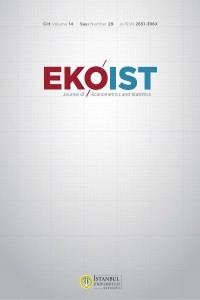EKONOMİK BÜYÜME VE REKABET GÜCÜ ÜZERİNE TÜRKİYE ANALİZİ
Türkiye’nin rekabet gücü yapısı zamana göre değişmektedir. Karar vericiler için Türkiye’nin hangi sektörlerde karşılaştırmalı üstünlüğe sahip olduğunun ve ekonomik büyümeyi olumlu gönde etkilediğinin bilinmesi politika yapım sürecinden önem arz etmektedir. Bu çalışmada Türkiye’nin rekabet gücü 10 farklı sektör için Balassa ve Lafay endekslerine göre hesaplanmıştır. Kişi başına sermaye birikimi, KOF endeksiyle ifade edilen küreselleşme endeksi ve rekabet gücü endekslerinin Türkiye kişi başına GSYİH’sı üzerindeki etkileri sınır testleri yardımıyla incelenmiştir. Sonuç olarak bazı sektörlerin Türkiye ekonomik büyümesini olumlu yönde etkilerken bazılarının da olumsuz yönde etkilediği gözlenmiştir.
Anahtar Kelimeler:
Rekabet gücü, Balassa endeksi, Küreselleşme, ekonomik büyüme ve sınır testleri
ANALYSIS OF TURKEY ON ECONOMIC GROWTH AND COMPETITIVENESS
Turkey’s the structure of comparative advantages changes according to the time. It is important to know which sectors have comparative advantages and positive effects on the economic growth of Turkey for decision makers. In this study, Turkey’s competitive strengths in ten different groups sectors were examined by Balassa and Lafay indexes. The effects of capital formation per capita, globalization index which represented by KOF index and competitiveness on the GDP per capita growth rates were analyzed by bound testing. As a result, it was found that some of sectors have positive effects on the Turkish growth rates while some of them have negative effects
Keywords:
Competitiveness Balassa Index, Globalization, Economic Growth, Bound Tests,
___
- Alessandrini, Michele and Michael Enowbi Batuo (2010), “The Trade Specialization of SANE: Evidence from Manufacturing Industries”, The European Journal of Comparative Economics, 7 (1): 145-178.
- Amador, João, Sónia Cabral and José R. Maria (2011), “A Simple Cross-Country Index of Trade Specialization”, Open Economies Review, 22: 447–461.
- Anderson, Linda, Ola Gustafsson and Lars Lunderberg (2000), “Structural Change, Competition and Job Turnover in Swedish Manufacturing Industry 1964-96”, Review of International Economics, 8: 566-582.
- Bhagwati, J (2004). In Defense of Globalization. NY: Oxford University Press.
- Business Council of Australia, Improving International Competitiveness in Australian Business, Melbourne, 2008.
- Chang, Ha-Joon, Kalkınma Reçetelerinin Gerçek Yüzü, (Çev. T. A. Onmuş), İletişim Yayınları, 2004, İstanbul.
- Choudri, E.U. and Schembri, L.L. (2002) “Productivity performance and international competitiveness: An old test reconsidered”, Canadian Journal of Economics 35(2); 341-362.
- Demir, İbrahim, Türkiye Beyaz Eşya Sanayinin Rekabet Gücü ve Geleceği, Devlet Planlama Teşkilatı İktisadi Sektörler ve Koordinasyon Genel Müdürlüğü Sanayi Dairesi Başkanlığı Uzmanlık Tezi, DPT Yayın No.2571, Ankara, 2001.
- Dolar, David and Aart Kraay (2002), “Growth is Good for the Poor”, Journal of Economic Growth, 7: 195-225.
- Edward, Sebastian (1992), “Trade Orientation, Distortions and Growth in Developing Countries”, Journal of Development Economics, 39 (1): 31-57.
- Edward, Sebastian, Trade and Industrial Policy in Latin America, Working Paper No. 4772, 1994.
- Feder, Gershon (1982), “On Exports and Economic Growth”, Journal of Development Economics, 12: 59-73.
- Fagerberger, Jan (1996), “Technology and Competitiveness,” Oxford Review of Economic Policy, 12 (3): 39-51.
- Farrugia, Nadia (2002), “Index of International Competitiveness for Malta” FarrBugainak of Valletta Review, 26: 20-37.
- Gerni, Cevat, M. Kemal Değer ve Ö. Selçuk Emsen (2008), “İthalata Dayalı İhracat ve Ekonomik Büyüme: 1980-2006 Türkiye Deneyimi”, İzmir İktisat Kongresi Anısına 2. Ulusal İktisat Kongresi, Dokuz Eylül Üniversitesi, İzmir, 20-22 Şubat 2008.
- Golub, S.S. and Hsieh, C.-T. (2000) “Classical Ricardian theory of comparative advantage revisited” Review of International Economics 8(2), 221-234.
- Gordon, Daniel V. and Kwabena Sakyi-Bekoe (1993), “Testing the Export-Growth Hypothesis: Some Parametric and Non-parametric Results for Ghana”, Applied Economics, 25: 553-563.
- Grossman, Gene M. and Elhanan Helpman, Innovation and Growth in the Global Economy, MIT Press, Cambridge MA, 1991.
- Hinloopen, Jeroen and Charles van Marrewijk (2012), “Power Laws and Comparative Advantage”, Applied Economics, 44: 1483-1507.
- Krugman, P (1994). Competitiveness: A dangerous obsession. Foreign Affairs 73(2), 28–44.
- Krugman, P. (1996) “Making Sense of the Competitiveness Debate,”Oxford Review of Economic Policy, Vol. 12:(3): 17-25.
- Medina-Smith, Emilio J. (2001), “Is the Export-Led Growth Hypothesis Valid for Developing Countries? A Case Study of Costa Rica”, United Nations Conference on Trade and Development, Policy Issues in International Trade and Commodities Study Series No. 7.
- Mostert, Johan (2003), “The Impact of Globalisation on Developing Countries”, The Economic Society of South Africa, (http://www.essa.org.za/ download/ papers2003.htm) (Aralık 2005).
- Nowak-Lehmann D., Felicitas; Sebastian; Vollmer and Inmaculada Martinez-Zarzoso, Does Comparative Advantage Make Countries Competitive? A Comparison of China and Mexico, Georg-August-University, Goettingen, Juli 2008.
- Porter, Michael E. And Victor E. Millar (1985), “How Information Gives You Competitive Advantage”, Harward Business Review, July-August: 1-13.
- Prebisch, Raşl, Five Stages in my Thinking on Development, In Dudley Seers, Cd., Pioneers in Development, Oxford: Oxford University Pres, 1984.
- Rutherford, Thomas F. and David G.. Tarr (1993), “Trade Reform in the Partially Liberalized, Economy of Turkey”, The World Bank Economic Review, 7 (2): 191-217.
- Salvatore, D (2004). International trade and economic development. Institutions and Economic Development, 6, 543–551.
- Salvatore, Dominick (2010), “Globalisation, International Competitiveness and Growth: Advanced and Emerging Markets, Large and Small Countries”, Journal of International Commerce, Economics and Policy, 1 (1): 21-32.
- Smith, Steve (1995), “World-class Competitiveness”, Managing Service Quality, 5 (5): 36-42.
- Stern, N (2002). A Strategy for Development. World Bank, Washington, DC.
- Stiglitz, J (2002). Globalization and Its Discontents. New York: W.W. Norton.
- KOF, Index of Globalization, http://globalization.kof.ethz.ch/, (Temmuz 2012).
- UNCTAD, United Nations Conference on Trade and Development, (UNCTAD) , http://unctadstat.unctad.org/ReportFolders/reportFolders.aspx, (Temmuz 2012). WB, World Bank Indicators (WB) http://databank.worldbank.org/ddp/home.do?Step=2&id=4&DisplayAggregation=N&SdmxS upported=Y&CNO=2&SET_BRANDING=YES, (Temmuz 2012).
- Yayın Aralığı: Yılda 2 Sayı
- Yayıncı: İstanbul Üniversitesi
